Helsinki Biennial 2025: ‘It is about creating alternative ways of living and being’
With climate change making Finland’s summers longer and its winters wetter, the third Helsinki Biennial has invited artists to imagine worlds ‘beyond human realities’. Jessica Lack discovers luminous glass sculptures of jellyfish and a sonic installation inspired by weeping trees
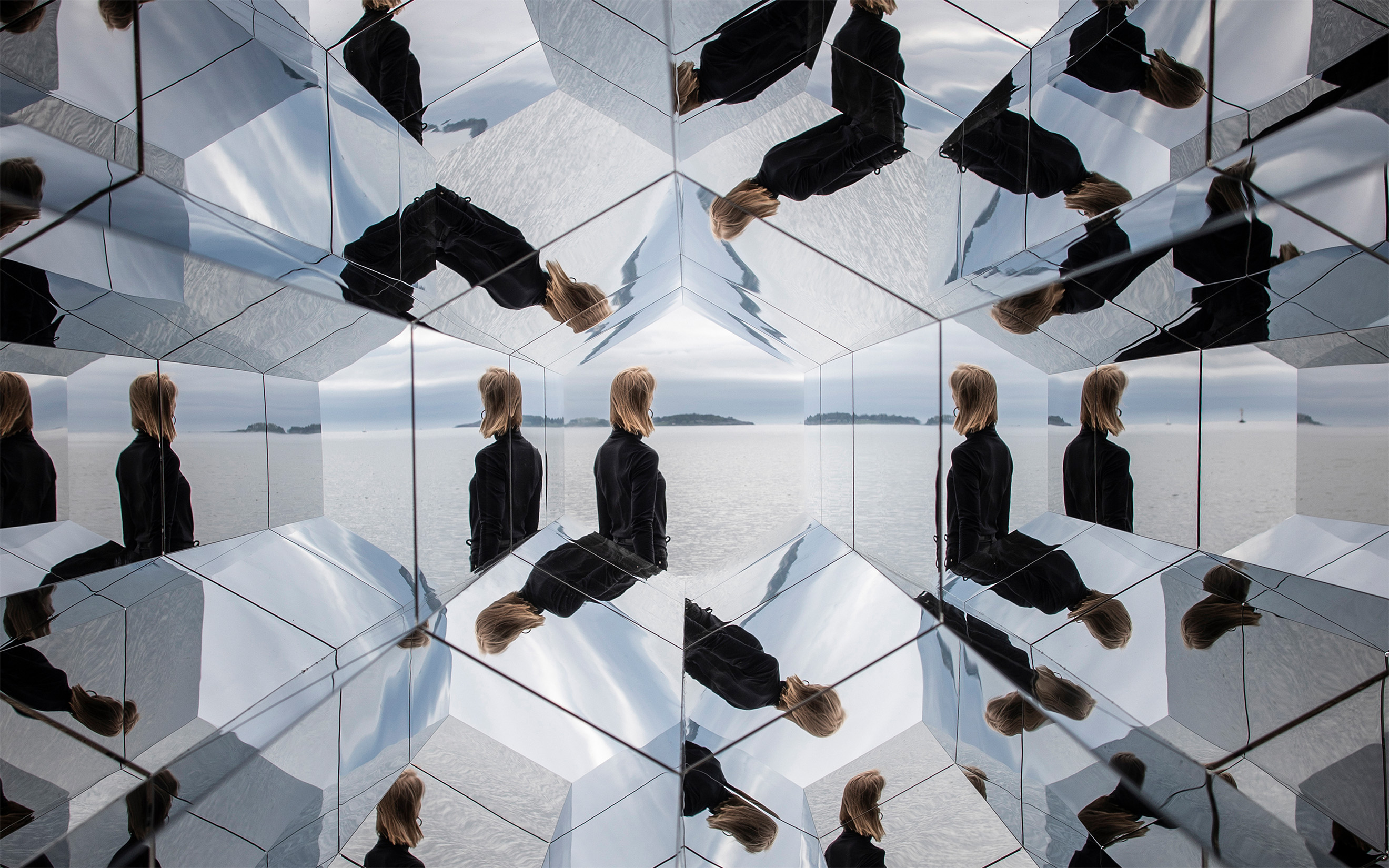
Olafur Eliasson (b. 1967), Viewing machine, 2001-03, at the Helsinki Biennial until 21 September 2025. © 2001/2003 Olafur Eliasson. Photo: HAM / Helsinki Biennial / Maija Toivanen
Olafur Eliasson’s kinetic Viewing machine (2001-03) is situated on an isthmus between the islands of Vallisaari and Kuninkaansaari in the Baltic Sea. As the giant kaleidoscope sways in the prevailing winds, its shimmering internal surfaces reveal nothing but the grey expanse of sea and sky that separates these tiny islands from the mainland and its Russian neighbour.
Out here, the sense of exposure is existential, something the writer W.G. Sebald might describe as a ‘godforsaken loneliness’. Until 2016, it was prohibited to approach Vallisaari, because it operated as a weapons depot for the military. Today the island is uninhabited, but it still retains traces of its forbidding past. Passengers alighting from the ferry are greeted with signs that warn of potential explosives.
If this all sounds a little dystopian, it is. Vallisaari is a paradise for lovers of Andrei Tarkovsky films (Andrei Rublev, Solaris, Stalker). Amid the tangled undergrowth and maple trees are derelict houses, old bunkers and an overriding sense of having trespassed. The strangeness is so all-encompassing that it is difficult for the artists exhibiting here to differentiate themselves from it. Ernesto Neto’s rope sculpture, woven between thin silver birches, and Ana Teresa Barboza’s fragile bark installations could be remnants of a once-thriving community now extinct.
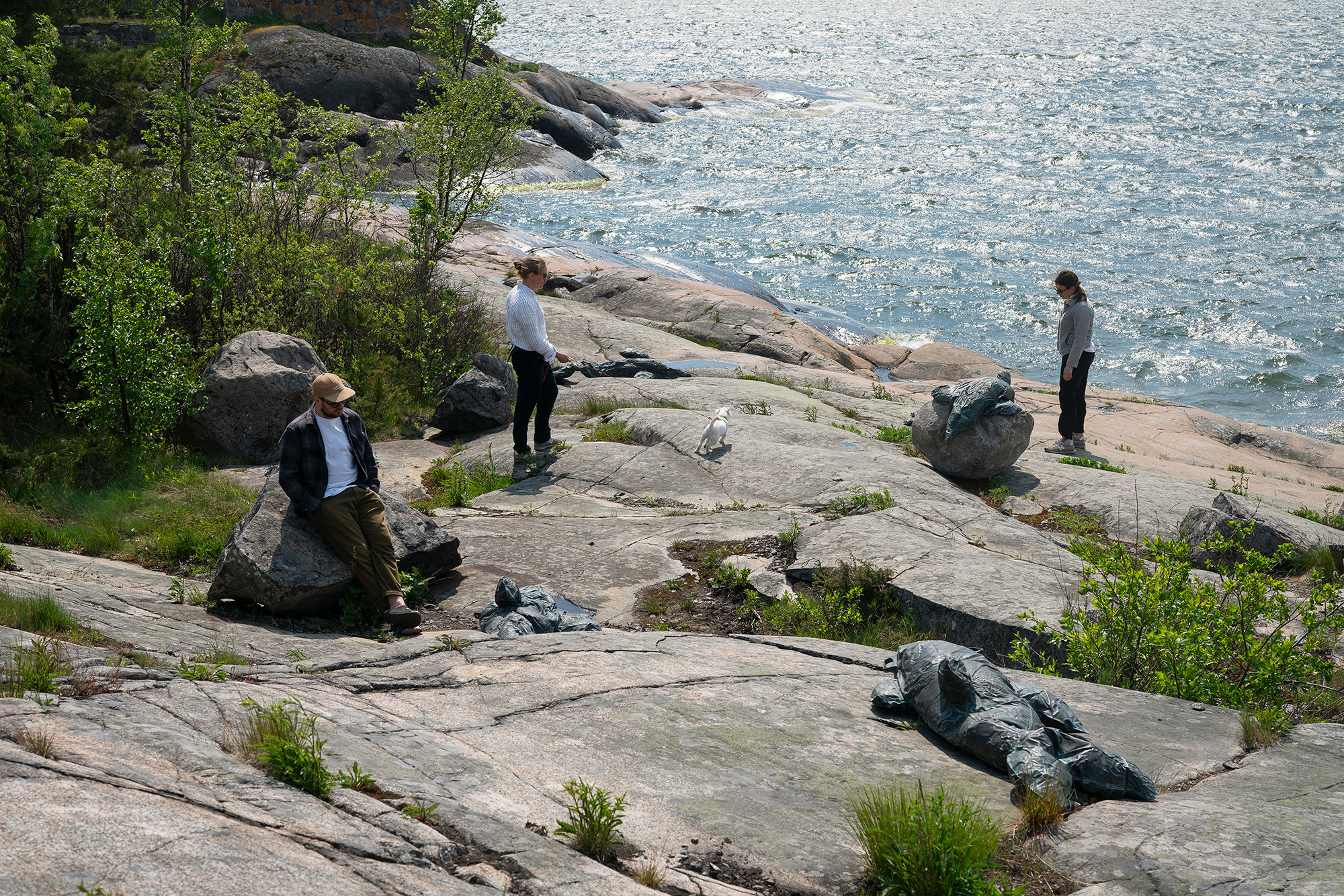
Sara Bjarland (b. 1981), Stranding, 2025 (detail), at the Helsinki Biennial until 21 September 2025. Photo: HAM / Helsinki Biennial / Sonja Hyytiäinen
The theme of this year’s Helsinki Biennial is ‘Shelter’, which reflects the political tensions in the region. Finland shares a 1,340km-long border with Russia, and in 2023 it joined NATO in response to its neighbour’s invasion of Ukraine. There have been efforts to renovate the country’s Cold War bomb shelters, and households have been encouraged to stockpile food in case of an emergency.
However, the curators are less interested in geopolitics than in climate change. The phenomenon known as ‘Arctic amplification’ — which has seen the Arctic warming nearly four times faster than the rest of the planet since 1979 — is raising average temperatures more quickly in Scandinavia than anywhere else in the world. Finland’s summers are lengthening, and its winters are getting wetter. As deforestation accelerates, biodiversity is rapidly declining.
The scale of the crisis has led to a psychological state known as ‘solastalgia’, a paralysing sense of helplessness in the face of environmental degradation. Unusually, this distress seems to have energised the curators Blanca de la Torre and Kati Kivinen. They argue that now, more than ever, society needs to face up to impending ecological catastrophe and move beyond our human-centric perspective. The 37 artists participating in this year’s biennial have been asked to imagine worlds ‘beyond human realities’. Vallisaari, a habitat for rare species, is the prime example of what happens when the people leave and nature takes over.
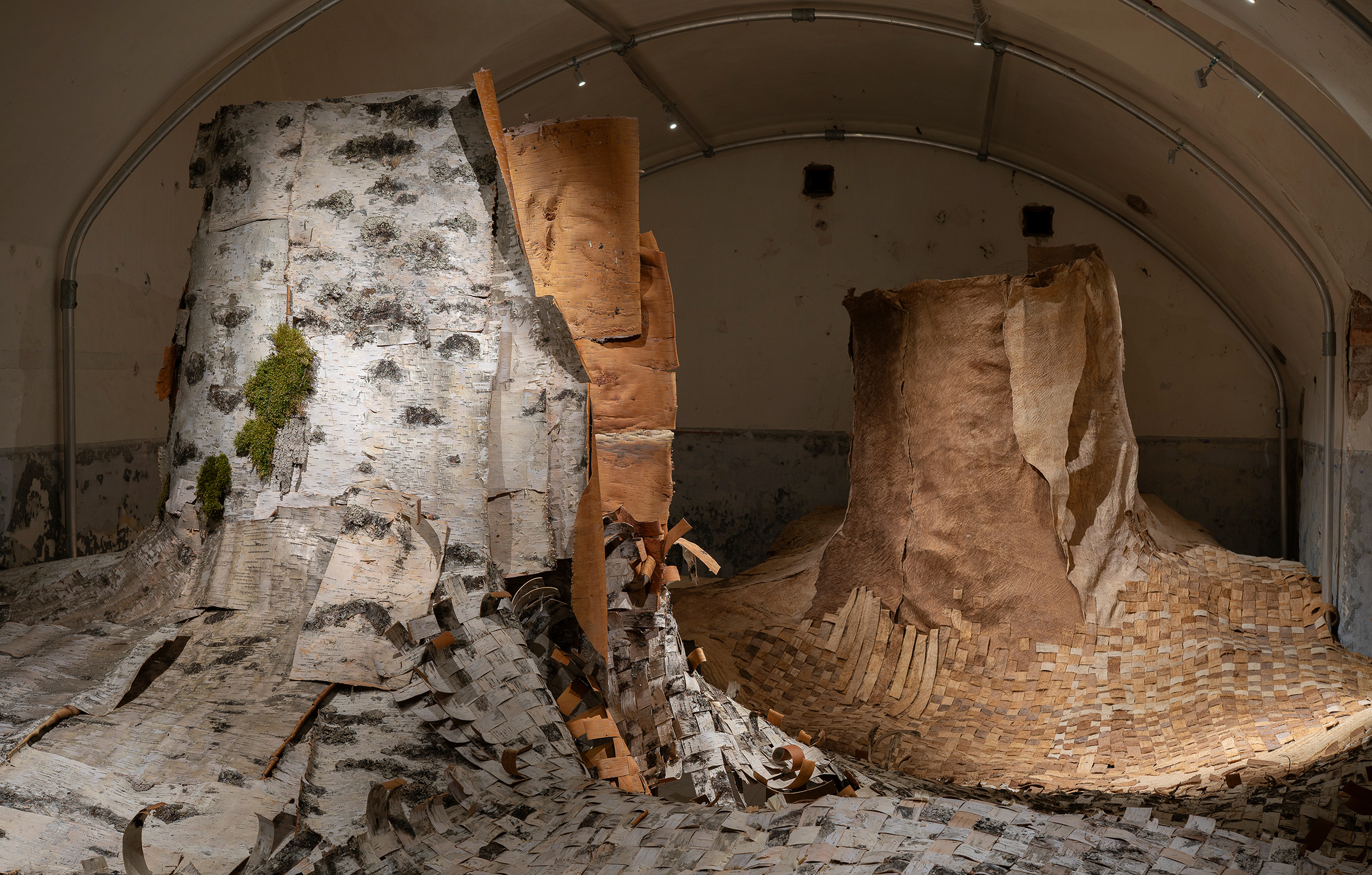
Ana Teresa Barboza (b. 1981), Interwoven Stories, 2025 (detail), at the Helsinki Biennial until 21 September 2025. Photo: HAM / Helsinki Biennial / Sonja Hyytiäinen
Juan Zamora’s subterranean installation engages with the philosophical implications of plant intelligence. He has worked with chemists to harness bioluminescent fluid, which he uses to paint delicate images of plants and insects that radiate inside an underground cavern.
The Weep of Trees (2021-23), a sonic installation by Band of Weeds, is inspired by a poem from the 19th-century Finnish epic The Kalevala, about a birch tree that laments its mistreatment before being chopped down and carved into a musical instrument. Data relating to environmental stress responses in deforested land is turned into music by the collective, and broadcast in a greenhouse on the island.
Nearby, a stack of blue pipes, originally used to drain peatlands, has been repurposed into a giant sculpture by Nomeda & Gediminas Urbonas. It is intended to evoke the protective tubular cases made by caddisfly larvae, the presence of which in wetlands is often an indicator of good water quality.
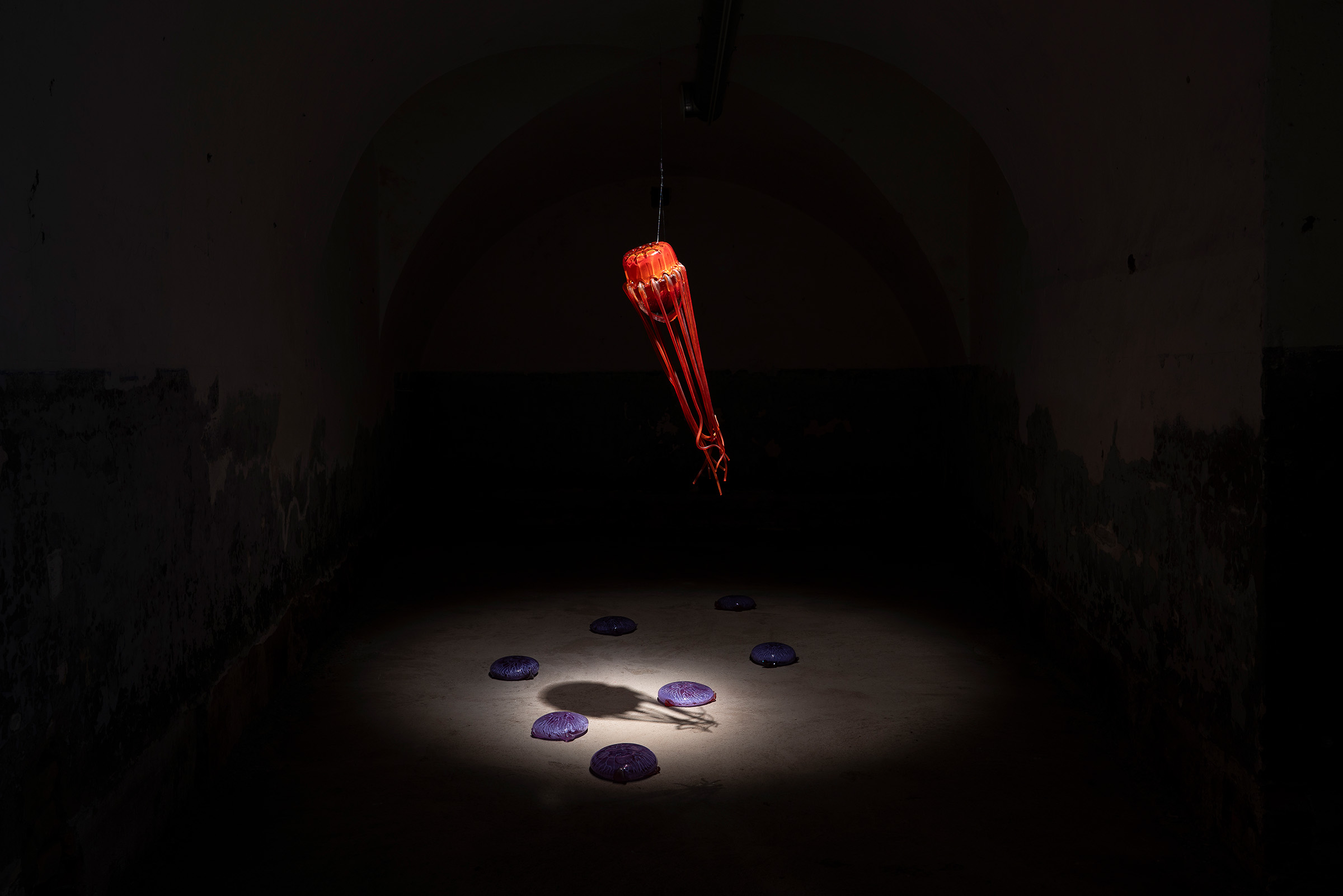
Tue Greenfort (b. 1973), Periphylla Periphylla I, 2016, and Ohrenqualle, Aurelia Aurita I-VII, 2022, at the Helsinki Biennial until 21 September 2025. Courtesy of König Galerie. Photo: HAM / Helsinki Biennial / Sonja Hyytiäinen
By contrast, the appearance of jellyfish can be a sign of planetary doom. As the oceans warm, jellyfish multiply and cause immense damage to coastlines. It is difficult to equate Tue Greenfort’s luminous glass sculptures of these beautiful animals with the water-borne zombies that spread destruction with their stinging mucus even after they have died. Sara Bjarland’s bronze casts of inflatable beach toys in the shape of dolphins and turtles, lying crumpled and lifeless on the island’s rocks, are perhaps a signal of what is to come.
Back on the mainland, artworks on show along Esplanade Park and at HAM Helsinki Art Museum consider, among other things, the legal implications of environmental destruction. Otobong Nkanga weaves the competing priorities of vast conglomerates, indigenous communities and the environment into a stunning abstract tapestry.
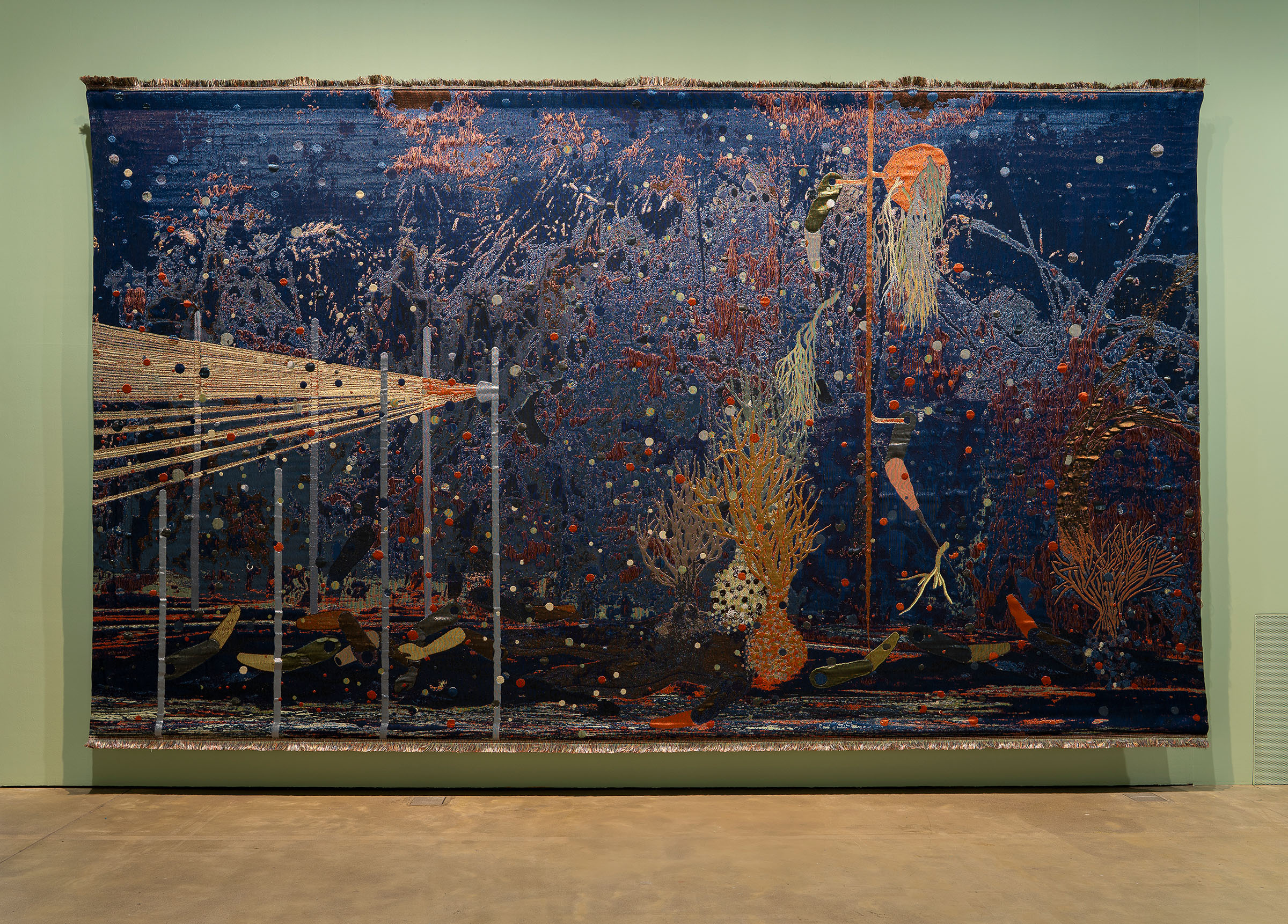
Otobong Nkanga (b. 1974), Tied to the Other Side, 2021, at HAM Helsinki Art Museum as part of the Helsinki Biennial until 21 September 2025. Photo: HAM / Helsinki Biennial / Sonja Hyytiäinen
There are collateral exhibitions at the Museum of Contemporary Art Kiasma and Amos Rex. At Kiasma, Monira Al Qadiri considers the curse of oil in the Gulf region, something that has distorted the natural course of development, creating a world of hyper-consumption and excess. Bloated metallic inflatables in the shape of molecular structures hang from the ceiling, while two blackened hands rise up from a bath of oil.
At Amos Rex, Anna Estarriola’s Staged Circumstances and Piles of Things is an exhibition for the end of times. Masked mannequins dressed in Day-Glo leisurewear operate in a futuristic limbo. The mood is dark, despite the figures’ carnivalesque appearance, and intrigue turns to disquiet when a look inside a giant beanie hat reveals multiple wigs whispering about the hereafter. By the time visitors arrive at the final installation, featuring an intergalactic conference of alien life forms, there is a sense that Estarriola’s vision of death and the cosmos is not one we would choose to participate in.
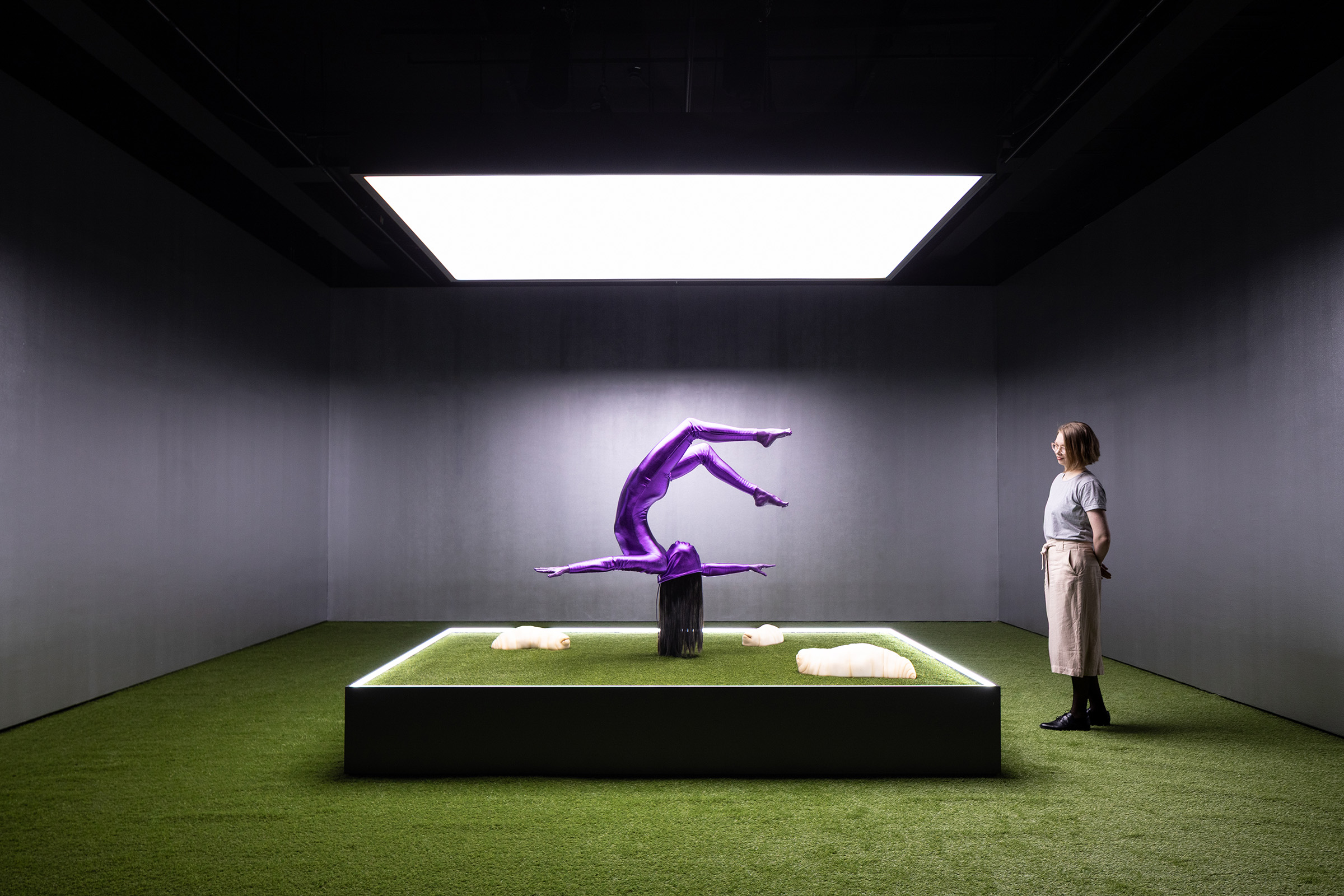
Anna Estarriola (b. 1980), Moment, 2023, part of her solo exhibition Staged Circumstances and Piles of Things at Amos Rex in Helsinki until 31 August 2025. Photo: Aukusti Heinonen / Amos Rex
Kieran Long, the director of Amos Rex, believes Helsinki is having a moment. ‘You can feel it,’ he says. ‘The eyes of the world have shifted in this direction.’ The government’s plans to make the country carbon neutral by 2035 — 15 years ahead of the global target envisioned by the Paris Agreement — will set an example to the world. It is courageous, and is being closely watched. ‘Finland is paving the way. It is about creating alternative ways of living and being,’ says Long.
Sign up for Going Once, a weekly newsletter delivering our top stories and art market insights to your inbox
His words echo Maria Thereza Alves’s The Council of Beings (2022-23), one of the most evocative artworks at HAM. The Brazilian artist’s ephemeral watercolours and sculptures imagine new democracies for the planet, giving non-human entities a place at the table and voting rights in the decision-making process. In a recent interview, she said, ‘Perhaps we can begin by listening to plants in the quiet of the night.’
The Helsinki Biennial runs until 21 September 2025 on Vallisaari Island, in Esplanade Park and at HAM Helsinki Art Museum. Monira Al Qadiri: Deep Fate is at the Museum of Contemporary Art Kiasma until 7 September. Anna Estarriola’s show, Staged Circumstances and Piles of Things, is at Amos Rex until 31 August